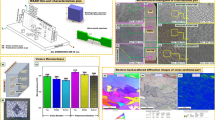Abstract
There is conflicting evidence in the literature with respect to the effect of grain size on hydrogen embrittlement. Differences may arise because of the degree of segregation in different grain size materials, because of different structures obtained in the effort to produce varying grain sizes, or because of the grain-size dependency of diffusion and growth processes. An extremely dirty heat of 4340 steel with 0.07 S and 0.015 P was investigated so that any tramp element segregation or hydrogen recombination poison effects would be present. Measurements were obtained on cathodically-charged samples with average grain sizes of 20, 50, 90 and 140 μm. In general, tramp element effects were not controlling. For those cases where the grain diameter was significantly larger than the plastic zone, increased grain size improved resistance. This was reflected by a slight increase in threshold stress intensity and an inverse grain-size squared dependence of crack velocity. Although the data are consistent with a pressure tensor hydrogen-assisted migration model, they could also be interpreted in terms of high austenitizing temperatures promoting retained austenite.
Similar content being viewed by others
References
W. W. Gerberich:Hydrogen in Metals, I. M. Bernstein and A. W. Thompson, eds., p. 115, American Society for Metals, 1974.
W. W. Gerberich and Y. T. Chen:Scripta Met., 1974, vol. 8, p. 243.
A. E. Schuetz and W. D. Robertson:Nace Technical Committee Report, 1957, publication 57-17, vol. 13, p. 437.
W. A. Van Der Sluys:Eng. Fract. Mech., 1969, vol. 1, p. 447.
S. Kortovich and E. A. Steigerwald:Eng. Fract. Mech., 1972, vol. 4, p. 637.
H. H. Johnson, J. G. Morlet, and A. R. Troiano:Trans. TMS-AIME, 1958, vol. 216, p. 528.
G. L. Hanna, A. R. Troiano, and E. A. Steigerwald:Trans. ASM, 1964, vol. 57, p. 658.
R. Barthand E. A. Steigerwald:Met. Trans., 1970, vol. 1, p. 3451.
E. A. Steigerwald, F. W. Schalle.-, and A. R. Troiano:Trans. TMS-AIME, 1960, vol. 218, p. 832.
F. Barth, E. A. Steigerwald, and A. R. Troiano:Corrosion, 1969, vol. 25, no. 9. p. 353.
G. Sandoz:Met. Trans., 1972, vol. 3, p. 1169.
D. Beachem:Met. Trans., 1972, vol. 3, p. 437.
St. John and W. W. Gerberich:Met. Trans., 1973, vol. 4, p. 589.
B. F. Brown:Met. Rev., 1968, vol. 13, p. 171.
B. F. Brown:The Theory of Stress Corrosion Cracking in Alloys, J. Scully, ed., p. 186, W. J. Maney and Son, Leeds, England, 1971.
F. Brown and D. Beachem:Corr. Sci., 1965, vol. 5, p. 745.
W. A. Van Der Sluys:J. Basic Eng., Trans. ASME, Scr. D., 1967, vol. 89, p. 28.
A. J. Stavros and H. W. Paxton:Met. Trans., 1970, vol. 1, p. 3049.
S. Carter:Corrosion, 1969, vol. 25, no. 10, p. 423.
R. P. M. Proctor and H. W. Paxton:Trans. ASM, 1962, vol. 62, p. 989.
M.V. Hyatt:Corrosion, 1970, vol. 26, no. 11, p. 487.
N. Freed and J. M. Krafft:J. Mater., 1966, vol. 1, no. 4, p. 770.
W. E. Wood, E. R. Parker, and V. F. Zackay: “An Investigation of Metallurgi- cal Factors Which Affect the Fracture Toughness of Ultra High Strength Steel”, Report No. LBL-1474, Univ. of Cal., Berkeley, 1973.
A. R. Troiano:Trans. ASM, 1960, vol. 52, p. 54.
W. W. Gerbench, Y. T. Chen, and St. John:Met. Trans. A, 1975, vol. 6A, p. 1485.
B. Hyall and G. Krauss, Jr.:Trans. ASM, 1968, vol. 61, p. 169.
T. J. Koppenaal and E. Gold:Met. Trans., 1972, vol. 3, p. 2965.
R. T. Ault, K. O. McDowell, P. L. Hendricks, and T. M. S. Ronald:Trans. ASM, 1967, vol. 60, p. 79.
M. H. Peterson, B. F. Brown, R. L. Newbegin, and R. E. Groover:Corrosion, 1967, vol. 23, p. 1942.
S. Mostovoy, H. R. Smith, R. G. Lingwall, and E. J. Ripling:Eng. Fract. Mech., 1971, vol. 3, p. 291.
C.S. Carter:Eng. Fract. Mech., 1971, vol. 3, p. 1.
H. L. Dunegan and A. S. Tetelman:Eng. Fract. Mech., 1971, vol. 2, p. 387.
G. E. Kearnsand R. W. Staehle:Scripta Met., 1972, vol. 6, p. 631.
A. M. Sullivan:Eng. Fract. Mech., 1974, vol. 4, p. 65.
W. E. Wood: Oregon Post Graduate Center, private communication, 1975.
K. Yoshino and C. J. McMahon, Jr.:Met. Trans., 1974, vol. 5, p. 363.
P. Paris and G. Sih:Amer. Soc. Test. Mater. Special Tech. Pub. 381, 1965, p. 30.
B. B. Rath and I. M. Bernstein:Met. Trans., 1971, vol. 2, p. 2845.
R. A. McCoy and W. W. Gerberich:Met. Trans., 1972, vol. 4, p. 539.
Author information
Authors and Affiliations
Additional information
Formerly Graduate Student, Department of Chemical Engineering and Materials Science, University of Minnesota.
The present paper is based on a portion of the thesis submitted by J. F. Lessar in partial fulfillment of the requirement for the M.S. degree at the University of Minnesota.
Rights and permissions
About this article
Cite this article
Lessar, J.F., Gerberich, W.W. Grain Size Effects in Hydrogen-Assisted Cracking. Metall Trans A 7, 953–960 (1976). https://doi.org/10.1007/BF02644060
Received:
Issue Date:
DOI: https://doi.org/10.1007/BF02644060




